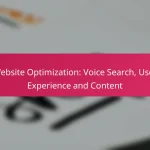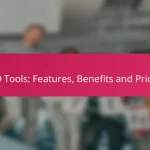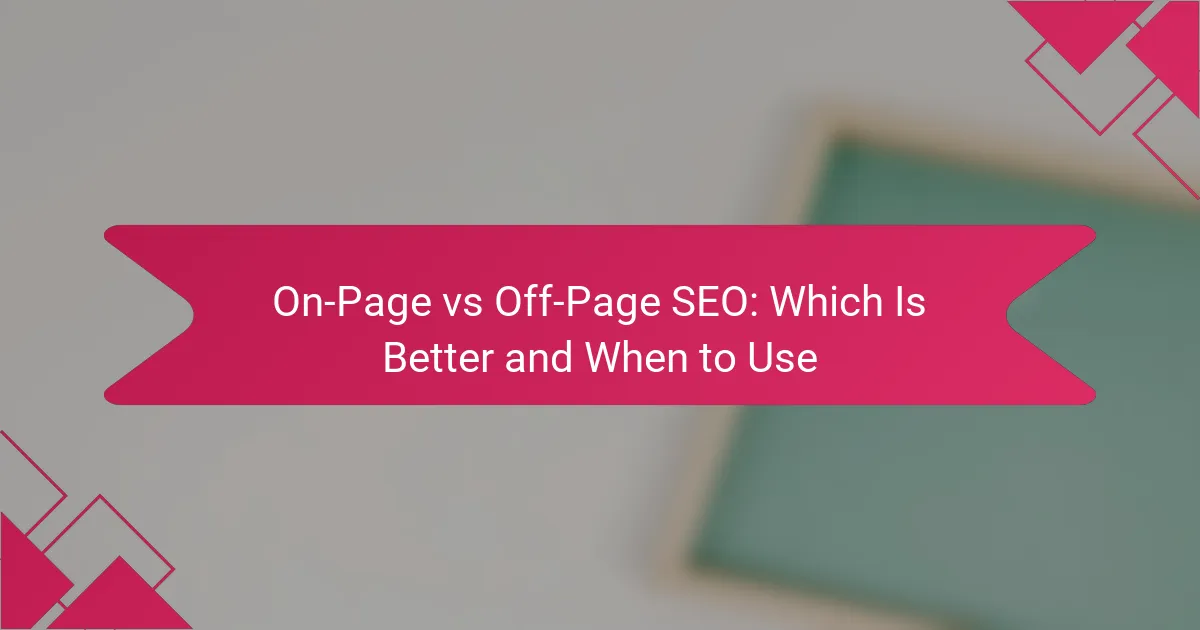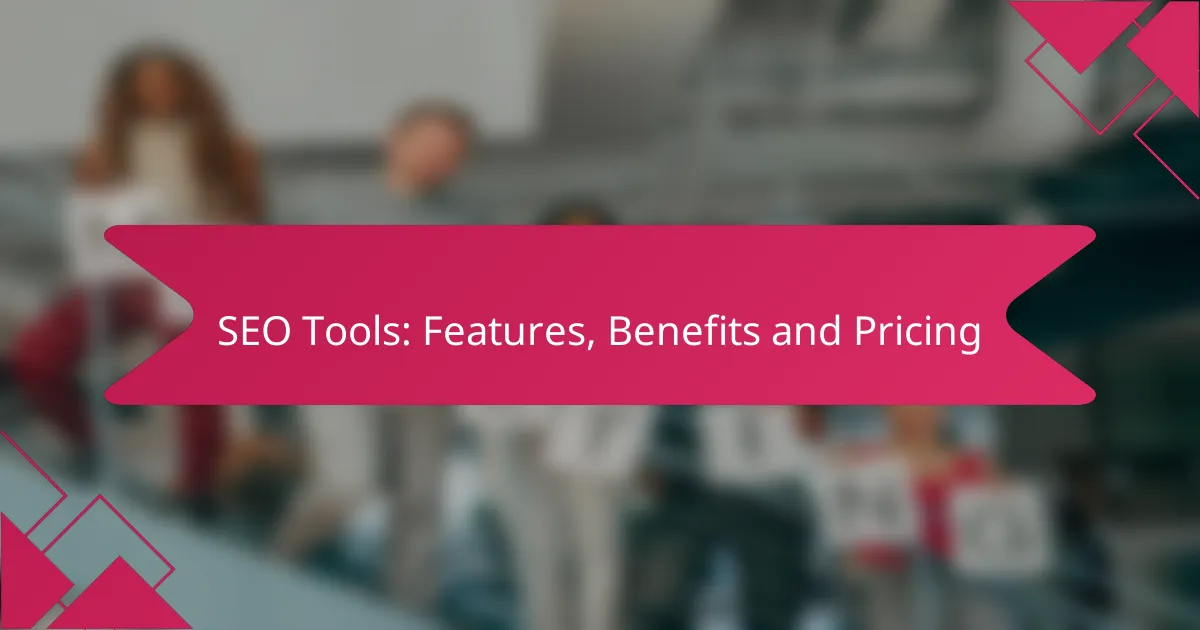On-Page and Off-Page SEO are two fundamental strategies that play crucial roles in enhancing a website’s visibility and ranking in search engines. On-Page SEO focuses on optimizing elements within your site, such as content and HTML tags, while Off-Page SEO emphasizes external factors like backlinks and social media engagement. Understanding when to use each approach is essential for developing a comprehensive SEO strategy that addresses both internal and external influences on your site’s performance.
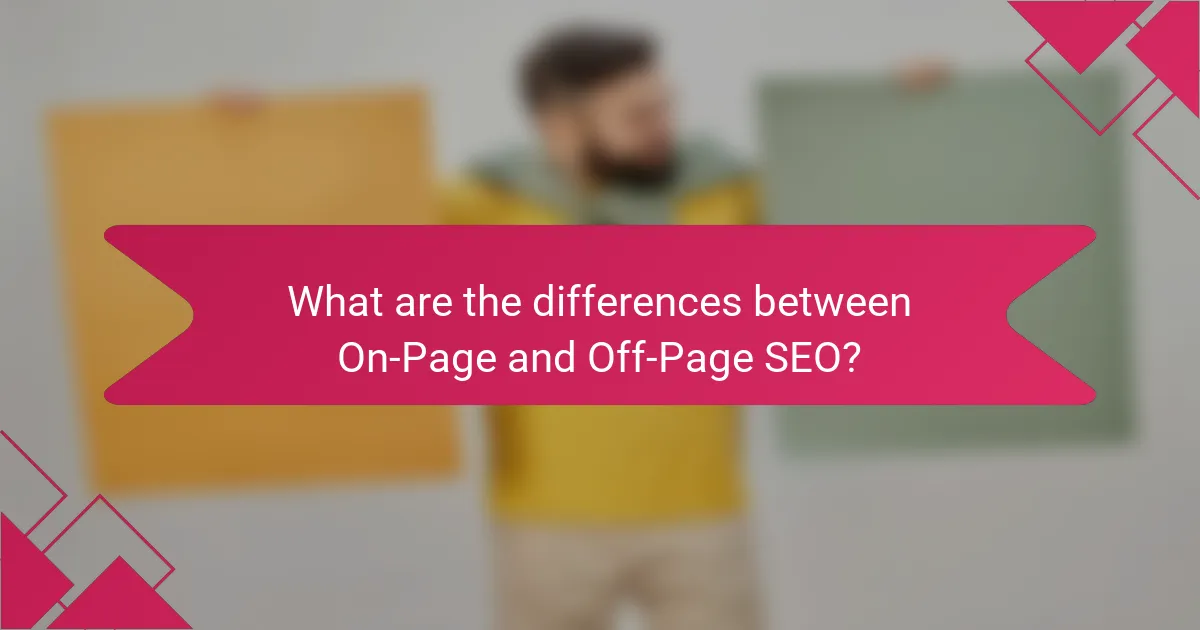
What are the differences between On-Page and Off-Page SEO?
On-Page SEO involves optimizing elements within your website to improve its visibility and ranking in search engines, while Off-Page SEO focuses on external factors that influence your site’s authority and relevance. Both strategies are essential for a comprehensive SEO approach, but they serve different purposes and require distinct tactics.
On-Page SEO focuses on website elements
On-Page SEO refers to the practice of optimizing individual web pages to rank higher and earn more relevant traffic. Key components include content quality, keyword usage, meta tags, and internal linking. For instance, ensuring that your content is well-structured with appropriate headings and keyword placement can significantly enhance user experience and search engine visibility.
To effectively implement On-Page SEO, regularly update your content, optimize images with alt tags, and ensure your website is mobile-friendly. Tools like Google Search Console can help identify areas for improvement.
Off-Page SEO emphasizes external factors
Off-Page SEO involves actions taken outside of your own website to impact your rankings within search engine results pages (SERPs). This includes building backlinks, social media marketing, and influencer outreach. High-quality backlinks from reputable sites signal to search engines that your content is valuable and trustworthy.
To enhance Off-Page SEO, focus on creating shareable content, engaging with your audience on social media, and participating in relevant online communities. Guest blogging can also be an effective way to earn backlinks and increase your site’s authority.
Key metrics for each approach
For On-Page SEO, key metrics include organic traffic, bounce rate, and average session duration. Monitoring these can help you assess how well your content is engaging visitors. Tools like Google Analytics provide insights into these metrics, allowing you to refine your strategy.
In contrast, Off-Page SEO metrics often focus on backlink quantity and quality, domain authority, and social media engagement. Tools like Moz and Ahrefs can help you track your backlink profile and overall site authority.
Impact on rankings and traffic
Both On-Page and Off-Page SEO significantly influence your website’s rankings and traffic. Effective On-Page SEO can lead to improved rankings for targeted keywords, resulting in increased organic traffic. Regularly optimizing your content can keep it relevant and competitive.
Off-Page SEO, particularly through quality backlinks, can enhance your site’s authority, leading to better rankings over time. A balanced approach that incorporates both strategies is crucial for sustained growth in visibility and traffic. Aim for a mix of both tactics to maximize your SEO efforts.

When should you use On-Page SEO?
On-Page SEO should be used when you want to optimize individual web pages to improve their ranking in search engines. This approach focuses on elements within your website, such as content quality, keyword usage, and HTML tags, to enhance visibility and user experience.
For immediate website optimization
On-Page SEO is ideal for immediate website optimization as it allows you to make changes directly on your site. By adjusting title tags, meta descriptions, and header tags, you can quickly improve your search engine rankings. Regularly updating these elements can lead to noticeable improvements in traffic within days or weeks.
Consider conducting an SEO audit to identify areas needing improvement. Tools like Google Search Console and SEMrush can help pinpoint issues such as broken links or slow loading times, which can be addressed promptly.
To improve user experience and engagement
Improving user experience and engagement is a key benefit of On-Page SEO. By optimizing content for readability, using clear headings, and incorporating multimedia elements, you can make your site more appealing to visitors. This can lead to lower bounce rates and higher time spent on the page.
Focus on creating high-quality, relevant content that answers users’ questions. Incorporating internal links can guide visitors to related topics, enhancing their overall experience and encouraging them to explore more of your site.
When launching new content
When launching new content, On-Page SEO is essential for ensuring that your pages are indexed and ranked effectively. Properly optimizing new articles or product pages with relevant keywords, engaging meta descriptions, and structured data can significantly enhance their visibility in search results.
Before publishing, conduct keyword research to identify terms your target audience is searching for. Use these keywords naturally in your content, headings, and alt text for images to maximize the chances of ranking well from the outset.

When should you use Off-Page SEO?
Off-page SEO should be utilized when you aim to enhance your website’s authority and visibility through external factors. This includes building backlinks, engaging in social media, and leveraging online reputation, which can significantly impact your search engine rankings.
To build domain authority
Off-page SEO is essential for building domain authority, which is a measure of your website’s credibility and trustworthiness. This can be achieved by acquiring high-quality backlinks from reputable sites, as search engines view these links as endorsements. Aim for links from sites with high domain authority themselves to maximize the impact.
Consider strategies such as guest blogging, partnerships, and influencer collaborations to generate these valuable backlinks. Regularly monitor your backlink profile to ensure quality and relevance, avoiding links from spammy or unrelated sites.
For enhancing brand visibility
Enhancing brand visibility through off-page SEO involves promoting your brand across various platforms and channels. This can include social media marketing, content marketing, and engaging with online communities relevant to your niche. The more your brand is mentioned and linked to, the more recognizable it becomes to potential customers.
Utilize social media platforms to share valuable content and engage with your audience. Participate in forums and discussions to establish your brand as an authority in your field. Consistency in your messaging and presence across platforms is key to building a strong brand image.
When competing in saturated markets
In saturated markets, off-page SEO becomes crucial for standing out among competitors. Focus on building a robust backlink profile and enhancing your online reputation to differentiate your brand. Engaging in outreach and PR campaigns can help you gain visibility in crowded spaces.
Consider leveraging unique content that addresses specific pain points or interests of your target audience. Collaborating with industry influencers can also amplify your reach and credibility, making it easier to capture the attention of potential customers in a competitive landscape.
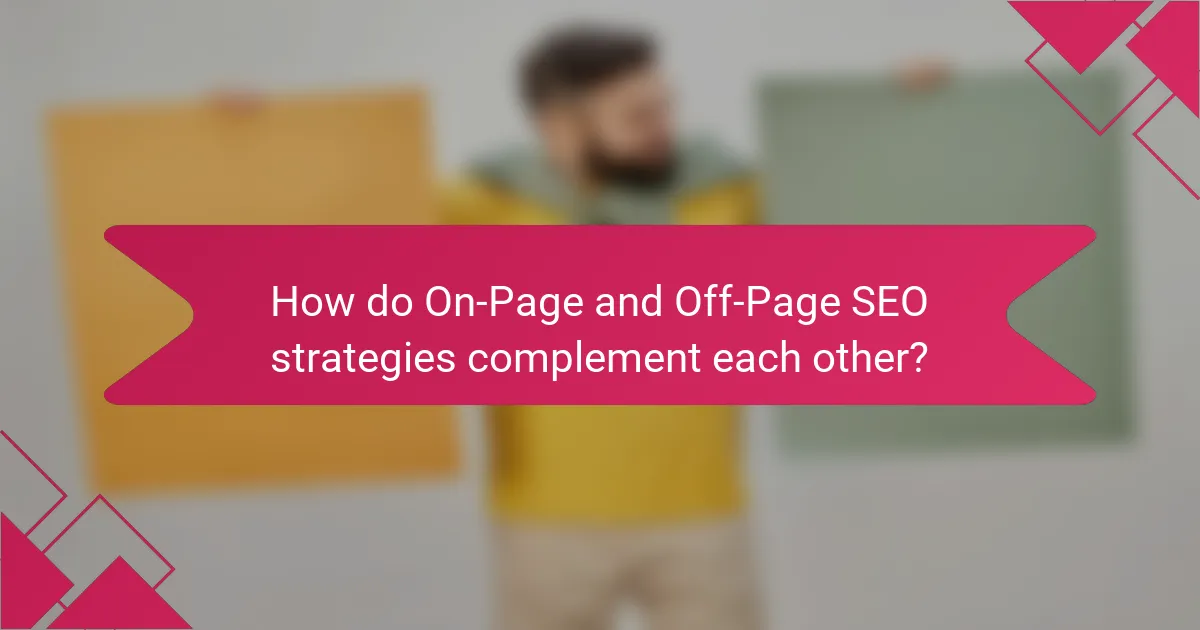
How do On-Page and Off-Page SEO strategies complement each other?
On-Page and Off-Page SEO strategies work together to enhance a website’s visibility and authority in search engine results. While On-Page SEO focuses on optimizing individual web pages, Off-Page SEO builds credibility and relevance through external factors.
Synergistic effects on search rankings
The combination of On-Page and Off-Page SEO can lead to improved search rankings. For instance, well-optimized content (On-Page) can attract backlinks (Off-Page), which in turn signals to search engines that the content is valuable. This synergy can create a positive feedback loop that boosts overall site authority.
To maximize these effects, ensure that your content is not only relevant and keyword-rich but also shareable and engaging. High-quality content is more likely to earn backlinks, which can significantly enhance your search performance.
Balancing internal and external signals
Balancing internal signals from On-Page SEO with external signals from Off-Page SEO is crucial for a holistic approach. Internal signals include factors like keyword usage, meta tags, and site structure, while external signals encompass backlinks, social media engagement, and brand mentions.
For effective optimization, regularly audit your On-Page elements to ensure they align with your Off-Page efforts. For example, if you gain new backlinks from reputable sites, update your internal linking strategy to reflect this authority, enhancing user experience and search visibility.

What tools can help with On-Page SEO?
Several tools can enhance On-Page SEO by analyzing and optimizing various aspects of your website. These tools help identify keywords, improve content quality, and ensure technical elements are in place for better search engine visibility.
SEMrush for keyword analysis
SEMrush is a powerful tool for keyword analysis that allows users to research and identify high-value keywords for their content. It provides insights into search volume, keyword difficulty, and competitive analysis, enabling you to select the most effective keywords for your target audience.
When using SEMrush, focus on long-tail keywords that have lower competition but still attract relevant traffic. This can lead to better ranking opportunities and higher engagement rates. Regularly updating your keyword strategy based on SEMrush data can keep your content relevant and competitive.
Yoast SEO for content optimization
Yoast SEO is a popular plugin for WordPress that assists in optimizing content for search engines. It provides real-time feedback on keyword usage, readability, and overall SEO score, allowing you to make adjustments as you write.
To effectively use Yoast SEO, ensure you follow its recommendations for keyword placement, meta descriptions, and internal linking. This can significantly improve your content’s visibility. Avoid keyword stuffing; instead, focus on natural language that enhances user experience while still being optimized for search engines.

What tools can help with Off-Page SEO?
Several tools can enhance your Off-Page SEO efforts by analyzing backlinks, tracking brand mentions, and facilitating content outreach. Utilizing these tools effectively can improve your site’s authority and visibility in search engine results.
Ahrefs for backlink analysis
Ahrefs is a powerful tool for analyzing backlinks, which are crucial for Off-Page SEO. It allows you to examine your website’s backlink profile, identify high-quality links, and discover potential link-building opportunities. You can also monitor competitors’ backlinks to find gaps in your own strategy.
When using Ahrefs, focus on metrics like Domain Rating (DR) and URL Rating (UR) to gauge the strength of your backlinks. Aim for a diverse backlink profile that includes links from various domains, as this can enhance your site’s authority.
BuzzSumo for content outreach
BuzzSumo is an excellent tool for content outreach, helping you identify influencers and popular content in your niche. By analyzing which topics resonate with audiences, you can create targeted content that is more likely to be shared and linked to by others.
To maximize your outreach efforts with BuzzSumo, create a list of influencers who have shared similar content and reach out to them with personalized messages. This approach can significantly increase your chances of gaining backlinks and improving your Off-Page SEO performance.
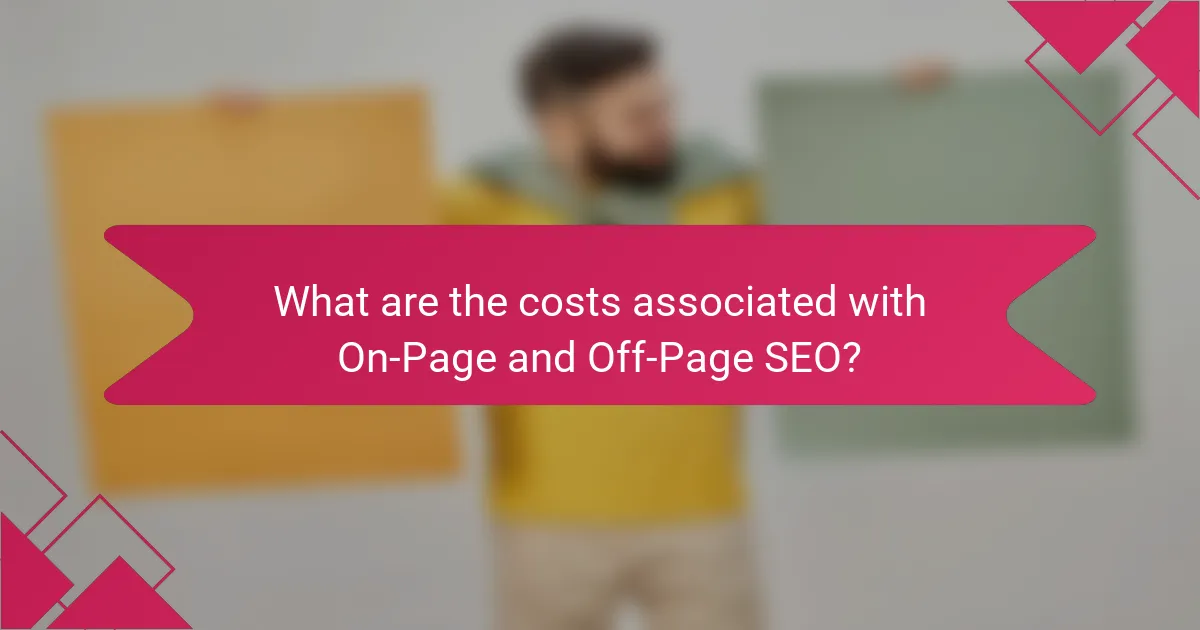
What are the costs associated with On-Page and Off-Page SEO?
The costs of On-Page and Off-Page SEO can vary significantly based on the strategies employed and the scale of implementation. On-Page SEO typically involves expenses related to content creation, website optimization, and technical enhancements, while Off-Page SEO costs often stem from link-building efforts, social media marketing, and outreach campaigns.
On-Page SEO Costs
On-Page SEO costs generally include expenses for content development, keyword research, and website optimization tools. Hiring freelance writers or agencies can range from a few hundred to several thousand dollars per month, depending on the volume and quality of content needed. Additionally, investing in SEO tools like SEMrush or Ahrefs may add a monthly fee of around $100 to $400.
Technical SEO improvements, such as site speed optimization or mobile responsiveness, may require further investment in web development services. This can cost anywhere from a few hundred to several thousand dollars, depending on the complexity of the changes required.
Off-Page SEO Costs
Off-Page SEO costs primarily arise from link-building strategies and promotional activities. Hiring professionals for link-building can range from $500 to $5,000 per month, depending on the number of links and the quality of the websites involved. Outreach campaigns, which may include influencer marketing or guest blogging, can also incur additional costs, often starting at a few hundred dollars.
Social media marketing is another component of Off-Page SEO, where costs can vary widely based on the platforms used and the advertising budget. Small businesses might spend a few hundred dollars monthly on ads, while larger companies could allocate thousands to enhance their online presence.
